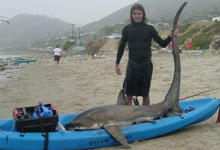Post
Kayak Fishing
Fishing Stories, Tackle Tips & How To's theangler PM

Sea kayaks can offer the brave-hearted fisherman a chance to venture into frothy coastal waters to reel in the big one.
Imagine paddling against the wind toward the angry Pacific Ocean in a kayak weighing less than most of the fish you hope to catch. Through the kelp beds that pepper Monterey Bay and past seals and sea otters, you find a spot not far from the lip of an underwater canyon and drops your line with a dead squid attached.
Minutes later, it’s possible to snag a small lingcod, a coastal fish that sometimes tops 50 pounds. It’s good eating, but there are bigger catches to be had.
Fishing from a kayak, California residents say, can get a whole lot more interesting. The Pacific teems with monstrous fish and it’s possible to catch many of them from a boat small enough to carry on one’s shoulder.
Kayak fishing enthusiasts say their sport is gaining in popularity across the United States, with kayak manufacturers, such as Perception, reporting dramatic increases in sales. Those taken with the sport say their lightweight watercraft are cheaper and more environmentally friendly than powerboats and, most importantly, provide some extreme experiences.
Kayak anglers, mostly for safety reasons, almost always go out in twos so there is a witness to verify the stories of their adventures. Sharks and kayak fishing
Stories abound of kayakers being pulled as much as 8 miles out to sea by a marlin. California kayakers also tell stories of seeing large white sharks leap out of the water while attacking a sea lion just feet from their kayak. It gives you a new respect for fishing in the ocean.
Anyone who understands what they are doing in this sport knows not to mess around with sharks, especially of the mako shark.
Imagine a thrashing shark weighing maybe 200 pounds, full of teeth and jumping out of the water and he’s coming toward you. You’ve got to cut the line and fast. You do not want him in a kayak with you. Fog and kayak fishing
There are other hazards. Fog can roll in without warning, disorienting a kayaker. The wind and waves can pick up quickly and swamp or overturn the craft. In the 55-degree waters off northern California, hypothermia is another peril.
Still, guides in California say the sport also is drawing fans along the East Coast and the Gulf of Mexico.
The price of kayak fishing alone makes it attractive. You can get totally outfitted in a kayak for around $1,000. It could cost tens of thousands to get into a powerboat.
It’ll catch on a lot faster once people understand that it can be safe and it can be fun … and that you don’t have to be into extreme sports to do it.”Kayaks coming into their own as fishing platforms
Kayaks are now employed to catch white sea bass in Southern California, tarpon in Florida, trout in Michigan and salmon in Alaska. Proponents formerly had to customize open kayaks, adding rod holders and bins to enable angling. Now, major gear makers are churning out models tailored for the sport.
Kayaks are proving to be the ultimate float tube.
When you use a kayak, you can explore nooks and coves and shallows. You don’t have to worry about investing in a motorboat, trailer and a big car to tow it. You don’t have to find a ramp, load up with gas, and then blow out fumes on your way to the fishing grounds.
Moving quietly, you can be a lot closer to marine mammals and birds. You’re more a part of the place where you are. It’s a better overall experience.
Although they offer convenient layouts, open kayaks do have a drawback. Nearly all (except for the Seda Revenge) are made of plastic. That makes them tough, but needlessly heavy. If kayak fishing continues to soar, we may see a new generation of open boats made of light composites — either fiberglass or Kevlar. Those should prove faster and a lot easier to unload and launch.
The excitement of scoring a hook-up and fight out on the ocean can light your nerves and you begin to see more possibilities for this form of fishing. That spark added to the enjoyment of seeing sea otters, sea lions, cormorants, and human board surfers up close in their native habitat, and the vigorous exercise in salt air provided by kayak fishing.
